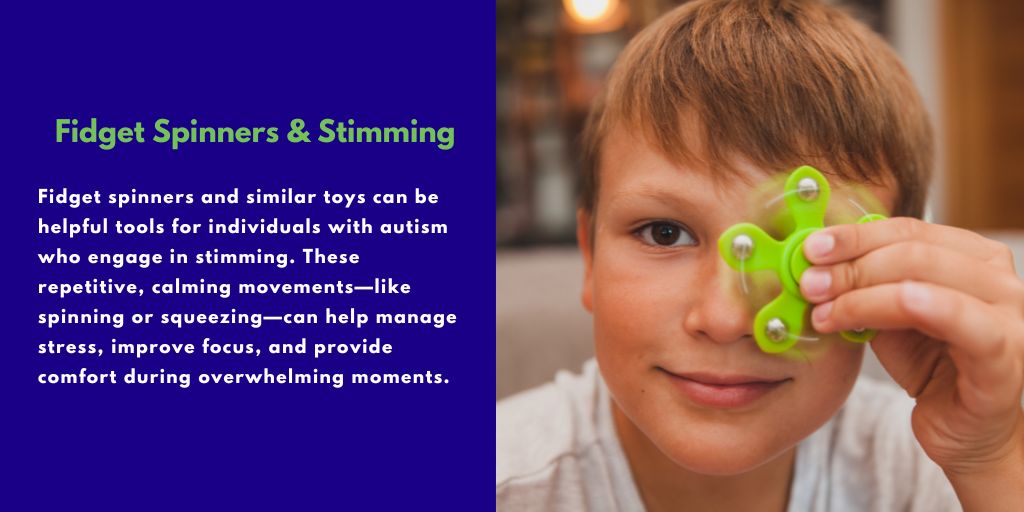Stimming is a common and natural expression for individuals with autism. These repetitive movements or sounds serve as a way to communicate, self-soothe, or process overwhelming emotions and sensory experiences.
Understanding the various types of stimming can offer valuable insight into your child’s needs and feelings. From hand-flapping and rocking to vocal repetitions, each behavior holds a purpose unique to the individual. This knowledge helps support your child and fosters a deeper connection and appreciation for how they experience the world.
At Applied ABC, we are dedicated to guiding families through the complexities of autism with compassion and expertise. If you’re seeking support for your child’s unique needs, our team is here to help. Explore our resources and services designed to empower parents and uplift every child’s potential. Call us at 866-352-5010 or submit this online contact form today to learn more.
What is Stimming in Autism?
Stimming refers to repetitive movements, actions, or sounds that autistic individuals use to regulate their emotions, process sensory input, or express themselves. While everyone engages in some form of stimming, like tapping a pen, twirling hair, or pacing, autistic people may stim in ways that are more pronounced or unique.
Stimming is a key component of autism diagnosis, not because it is exclusive to autistic people but because its frequency and intensity can sometimes interfere with daily life. For some, stimming can provide comfort and help manage overwhelming emotions or sensory overload. Yet, in certain situations, stimming might become disruptive or misunderstood, especially when it involves behaviors outside of socially typical norms.
Examples of stimming behaviors in autism include rocking, finger-flicking, echolalia (repeating words or sounds), snapping fingers, or even covering and uncovering ears. While stimming isn’t inherently problematic, addressing it can be helpful when it hinders learning, engagement, or quality of life.
The Different Types of Stimming in Autism
Stimming behaviors in autism can vary widely and often play a meaningful role in how an individual interacts with their environment. By understanding the different types of stimming, parents and caregivers can gain deeper insight into these behaviors and how they serve each child’s unique needs.
Visual Stimming
Visual stimming involves repetitive behaviors centered on sight or eye movement, providing individuals with a soothing or engaging sensory experience. It may help process visual input or offer comfort in stressful or overstimulating situations. Using sensory tools like lighting displays with dynamic colors or patterns can be particularly appealing, as they provide a calming effect.
Common examples of visual stimming include staring at moving objects, such as ceiling fans or swirling screensavers, fixating on specific items for extended periods, repetitive blinking, or frequently turning lights on and off. These behaviors can serve unique purposes for those who engage in them, helping to regulate sensory input or process emotions.
Auditory Stimming
Auditory stimming involves repetitive sounds or noises, either created by the individual or derived from external sources. These behaviors can provide a sense of comfort, help manage sensory input, or offer an enjoyable auditory experience. Some sensory tools, like bubble tubes, emit soothing bubbling sounds that may appeal to autistic children engaging in auditory stimming.
Examples of auditory stimming include listening to the same song or sound repeatedly, humming, clapping, finger-clicking, or making specific vocalizations. These actions can serve as a way to self-soothe or stay engaged in certain environments.
Supporting auditory stimming with thoughtful accommodations, such as access to calming sounds or tools, can make a positive difference.
Tactile Stimming
Tactile stimming is centered around the sense of touch and involves repetitive contact with specific textures or sensations. For individuals with sensory processing differences, tactile experiences can be particularly significant, evoking a range of emotional or regulatory responses. These behaviors might help manage stress, process sensory input, or provide comfort.
Tools like vibrating sensory cushions can be a fantastic way to fulfill tactile needs or gently redirect stimming into appropriate outlets. Exploring textures and sensations in a supportive environment can improve self-regulation and engagement.
Examples of tactile stimming include rubbing hands together or against various surfaces, squeezing objects like stress balls, or leaning against walls or furniture to feel pressure.
Verbal Stimming
Verbal stimming involves the repetitive use of words, phrases, or sounds, often without a specific purpose. These vocalizations may be comforting, enjoyable to produce, or memorable from a sound they’ve heard before. For many children, verbal stimming serves as a way to process emotions or sensory input.
Adding sensory tools like sound equalizers can enhance the experience by creating visual feedback for the sounds produced. Common examples of verbal stimming include whistling, clicking the tongue, and repeating certain words or phrases over and over.
Oral and Olfactory Stimming
Oral and olfactory stimming focuses on the senses of taste and smell. Individuals may gravitate toward intense flavors like spicy or sour foods or seek out potent scents, even those others might find unpleasant.
Examples include chewing, biting, licking, grinding teeth, sniffing, or exploring objects using the mouth or tongue. Supporting these behaviors with safe and appropriate options can help meet sensory needs while encouraging healthy and engaging sensory exploration.
Vestibular and Proprioceptive Stimming
Vestibular stimming involves repetitive movements that affect balance and spatial orientation, while proprioceptive stimming focuses on body awareness. This type of stimming in autism enables individuals to sense limb positioning without direct visual input.
Both types of stimming can offer comfort, regulate sensory input, or even alleviate stress. Soft play areas are a fantastic tool for these needs, providing a secure and adaptable environment for physical exploration, movement, and sensory fulfillment.
Examples of vestibular and proprioceptive stimming may include spinning, rocking back and forth, jumping, rolling on the floor, pacing, or even throwing objects to interact with surroundings in unique ways.
Get Professional Support at Applied ABC
Stimming is a natural and meaningful way for autistic children to process sensory input, regulate emotions, or feel comfort in their unique experiences. By understanding the different forms of stimming, we can better appreciate the diverse ways children interact with their environments.
Creating supportive spaces and providing safe outlets for these behaviors allows your child to thrive while feeling respected and understood. At Applied ABC, we approach stimming with empathy and care to strengthen relationships and foster a world where neurodiversity is embraced and celebrated. Call us at 866-352-5010 or submit our online application form to get started.






